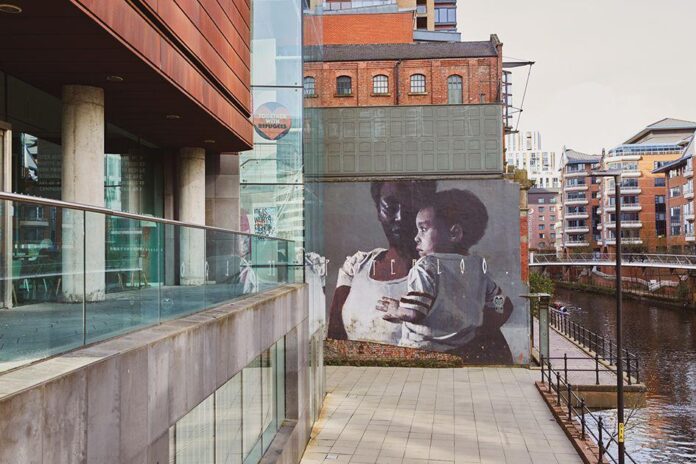• Read about the museums shortlisted for the Art Fund Museum of the Year 2022 here
At the People’s History Museum in Manchester, a programme of events and several exhibits are being decided upon. In the room are five staff members and five fully paid community contributors; each of them holds ten tokens ready to vote for the elements they would most like to see in the museum’s programme. It is democracy in action and how the People’s History Museum upholds the values it celebrates on its walls.
“As a museum we have co-curated all of our programmes since 2017,” explains Aine Graven, the head of development. “It is something we are committed to because you have to have authentic voices—and different lived experiences bring different perspectives on things.”
This is how the museum created Migration: A Human Story, by working with members of the migrant communities whose stories are told in the programme. And a very similar method will be used to curate upcoming programme Nothing About Us Without Us, which explores the history of disabled people’s rights and activism.
As the name suggests, the People’s History Museum has always placed the human element at the heart of its work. Founded in the 1960s in London by a group of activists, including the Trade Union Labour and Co-operative History Society (TULC), the museum started by collecting historical campaign materials about the rights of working people. Moving to Manchester in 1988 when the city council saved it from demise, the organisation now holds the largest collection of banners in the world and more than 60,000 objects.
The permanent galleries begin 200 years ago with Manchester’s Peterloo Massacre and run through strikes, wars, political battles and campaign victories, coming up to the modern-day struggles for migrants, those with disabilities and the LGBTQ community. Downstairs, the temporary exhibits are more dynamic and eclectic, and currently house the creative output of a collaborative group united by the murdered British MP Jo Cox’s “more in common than that which divides us” ethos. This section shows a film that challenges stereotypes of young people from Gypsy, Roma and Traveller of Irish Heritage backgrounds and has a timeline tracing the history of slavery and the British Empire.

The collection has more than 60,000 objects © Emli Bendixen/Art Fund
In the past year, the museum has stepped up a gear and transitioned from a place where campaigns are historicised to a place where campaigns are launched. “The Nationality and Borders Bill was an opportunity we couldn’t really pass on campaigning against,” says programme officer Zofia Kufeldt. “It takes away people’s human rights to seek asylum and we were working closely with the community of asylum seekers and refugees in Manchester for Migration: A Human Story. The feedback from the communities involved was that they wanted us to do more than just tell their stories and raise awareness, they wanted us to actively campaign with them.”
Consequently, a Together with Refugees postcard station was positioned next to the panel in the gallery that details how the 1951 UN Refugee Convention ensured that there was no illegal way to travel to the UK for the specific purpose of seeking asylum. Visitors were invited to write a postcard to the home secretary to urge a rethink of the Nationality and Borders Bill, introduced in April 2022, which directly contradicts the convention and penalises people for entering the country using certain means.
More than 250 postcards were sent to the government—not in an attempt to play politics but to stand up for human rights, says Kufeldt. “Everyone has the right to seek asylum and that’s why we were campaigning against the Nationality and Borders Bill. I think that’s how we will approach campaigning in the future as well.”
Instigating activism is now “hugely important” to the museum, says Graven. “That’s what we want people to take away – that they have power, they have a voice, they have the opportunity to do something, whatever they care about. You can take so many different things from the collections. Different things resonate with different people. I think if you leave here feeling powerless then we’ve not done our job.”
Empowering individuals is, unsurprisingly, the motivation behind the allocation of the potential £100,000 prize money. It is the organisation’s hope that, if they win, they will be able to fund more co-curated programmes with marginalised voices, paying them a fair wage in the process. The additional injection of cash would ensure that future exhibitions continue to come direct from the communities that are fighting for change. There is also a little mention of a party, and in anyone else’s hands this might sound indulgent, but for a museum that is built by and for the people, who knows what revolution such a party might spark?

The Journey We Made Across Land And Sea, To Build A Country Not Made For Me (2021) by Seleena Laverne Daye Image courtesy of People’s History Museum
Must-see: Banner by Seleena Laverne Daye
“The Journey We Made Across Land And Sea, To Build A Country Not Made For Me by Seleena Laverne Daye was commissioned in 2021 by the Community Programme Team, who wanted to create a ‘fake trade union banner’ to subvert the classical ideals seen in our banner collection. I think it conveys so much, and the more you look at it, the more you take out of it. It is such a visual representation of so much of what our programme Migration: A Human Story tries to tell, and I think it is so striking to see people represented that just aren’t present when you look at the rest of our collection of banners. These pieces of artwork are a fundamental part of our history of activism: more should look like this, and I hope they will in the future.”
Aine Graven, head of development, People’s History Museum

























